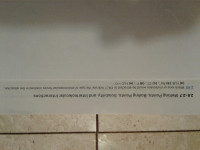
Introduction to General, Organic and Biochemistry
11th Edition
ISBN: 9781285869759
Author: Frederick A. Bettelheim, William H. Brown, Mary K. Campbell, Shawn O. Farrell, Omar Torres
Publisher: Cengage Learning
expand_more
expand_more
format_list_bulleted
Question
thumb_up100%

Transcribed Image Text:2.6-2.7 Melting Points, Boiling Points, Solubility, and Intermolecular Interactions
2.43 Which ions or molecules would be attracted to CH ? Indicate the type of intermolecular forces involved in the attraction.
(a) H20; (b) Na"; (c) CI; (d) F; (e) H2C=0
Expert Solution
This question has been solved!
Explore an expertly crafted, step-by-step solution for a thorough understanding of key concepts.
This is a popular solution
Trending nowThis is a popular solution!
Step by stepSolved in 3 steps

Knowledge Booster
Learn more about
Need a deep-dive on the concept behind this application? Look no further. Learn more about this topic, chemistry and related others by exploring similar questions and additional content below.Similar questions
- 6-53 Dioxin is considered to be poisonous in concentrations above 2 ppb. If a lake containing L has been contaminated by 0.1 g of dioxin, did the concentration reach a dangerous level?arrow_forward6-111 As noted in Section 6-8C, the amount of external pressure that must be applied to a more concentrated solution to stop the passage of solvent molecules across a semipermeable membrane is known as the osmotic pressure The osmotic pressure obeys a law similar in form to the ideal gas law (discussed in Section 5-4), where Substituting for pressure and solving for osmotic pressures gives the following equation: RT MRT, where M is the concentration or molarity of the solution. (a) Determine the osmotic pressure at 25°C of a 0.0020 M sucrose (C12H22O11) solution. (b) Seawater contains 3.4 g of salts for every liter of solution. Assuming the solute consists entirely of NaCl (and complete dissociation of the NaCI salt), calculate the osmotic pressure of seawater at 25°C. (c) The average osmotic pressure of blood is 7.7 atm at 25°C. What concentration of glucose (C6H12O6) will be isotonic with blood? (d) Lysozyme is an enzyme that breaks bacterial cell walls. A solution containing 0.150 g of this enzyme in 210. mL of solution has an osmotic pressure of 0.953 torr at 25°C. What is the molar mass of lysozyme? (e) The osmotic pressure of an aqueous solution of a certain protein was measured in order to determine the protein's molar mass. The solution contained 3.50 mg of protein dissolved in sufficient water to form 5.00 mL of solution. The osmotic pressure of the solution at 25°C was found to be 1.54 torr. Calculate the molar mass of the protein.arrow_forward6-38 Describe how we would prepare 250 mL of 0.10 M NaOH from solid NaOH and water.arrow_forward
- Will red blood cells crenate, hemolyze, or remain unaffected when placed in each of the solutions in Problem 8-107?arrow_forwardStarch contains CC, CH, CO, and OH bonds. Hydrocarbons have only CC and CH bonds. Both starch and hydrocarbons can form colloidal dispersions in water. Which dispersion is classified as hydrophobic? Which is hydrophilic? Explain briefly.arrow_forward6-31 If a bottle of beer is allowed to stand for several hours after being opened, it becomes "flat" (it loses CO2). Explain.arrow_forward
- Which of these compounds is most soluble in water and why? (A) CH4; it forms hydrogen bonding with water molecules. (B) NH3; it forms hydrogen bonding with water molecules. (C) PH3: it forms hydrogen bonding with water molecules. (D) All of them; they form hydrogen bonds with water molecules.arrow_forwardMm.9.arrow_forward2. Calculate the enthalpy of hydration of CuSO, if 16.34 g of CUSO, dissolves in water and gives out 55.51 kJ of heat (Q) and 25.17 g of CuSO4 • SH;O dissolves in water and absorbs 95.31 kJ of heat (Q). The molecular weight for CusO, is 160.00 g/mol, CusO, • SH;0 is 250.00 g/mol. Show ALL calculations-no calculations, no credit! CusO, (s) excess H,O Cu" (aq) so- (aq) AH1 + SH;0 АНа АНа excess H;0 CusO4 • SH20 (s)arrow_forward
- What is the boiling point elevation of a solution consisting of 125.1 g sucrose, C12H22O11, dissolved in 115.7 g of water, ? Kb = 0.512 °C/m.arrow_forwardHow does the value for the percent of water in CuSO4· 5 H2O change (increased, decreased, or remain the same) if: a) you did not heat the sample long enough to remove all of the water? b) some of the sample spattered out of the evaporating dish during heating?c) after heating, you wrote 41.698 g as the mass of the evaporating dish + sample instead of 41.598 g? (Explain your thinking).arrow_forwardCalc molalityarrow_forward
arrow_back_ios
SEE MORE QUESTIONS
arrow_forward_ios
Recommended textbooks for you
 Introduction to General, Organic and BiochemistryChemistryISBN:9781285869759Author:Frederick A. Bettelheim, William H. Brown, Mary K. Campbell, Shawn O. Farrell, Omar TorresPublisher:Cengage Learning
Introduction to General, Organic and BiochemistryChemistryISBN:9781285869759Author:Frederick A. Bettelheim, William H. Brown, Mary K. Campbell, Shawn O. Farrell, Omar TorresPublisher:Cengage Learning Chemistry: Principles and PracticeChemistryISBN:9780534420123Author:Daniel L. Reger, Scott R. Goode, David W. Ball, Edward MercerPublisher:Cengage Learning
Chemistry: Principles and PracticeChemistryISBN:9780534420123Author:Daniel L. Reger, Scott R. Goode, David W. Ball, Edward MercerPublisher:Cengage Learning ChemistryChemistryISBN:9781305957404Author:Steven S. Zumdahl, Susan A. Zumdahl, Donald J. DeCostePublisher:Cengage Learning
ChemistryChemistryISBN:9781305957404Author:Steven S. Zumdahl, Susan A. Zumdahl, Donald J. DeCostePublisher:Cengage Learning Chemistry: An Atoms First ApproachChemistryISBN:9781305079243Author:Steven S. Zumdahl, Susan A. ZumdahlPublisher:Cengage Learning
Chemistry: An Atoms First ApproachChemistryISBN:9781305079243Author:Steven S. Zumdahl, Susan A. ZumdahlPublisher:Cengage Learning

Introduction to General, Organic and Biochemistry
Chemistry
ISBN:9781285869759
Author:Frederick A. Bettelheim, William H. Brown, Mary K. Campbell, Shawn O. Farrell, Omar Torres
Publisher:Cengage Learning

Chemistry: Principles and Practice
Chemistry
ISBN:9780534420123
Author:Daniel L. Reger, Scott R. Goode, David W. Ball, Edward Mercer
Publisher:Cengage Learning


Chemistry
Chemistry
ISBN:9781305957404
Author:Steven S. Zumdahl, Susan A. Zumdahl, Donald J. DeCoste
Publisher:Cengage Learning

Chemistry: An Atoms First Approach
Chemistry
ISBN:9781305079243
Author:Steven S. Zumdahl, Susan A. Zumdahl
Publisher:Cengage Learning
